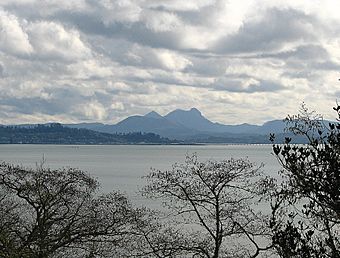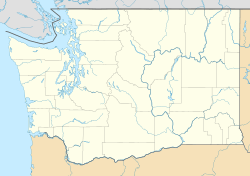Chinook Point facts for kids
|
Chinook Point
|
|

View from Fort Columbia across the mouth of the Columbia River to Astoria, Oregon, and Saddle Mountain.
|
|
| Nearest city | Chinook, Washington |
|---|---|
| Area | 286 acres (116 ha) |
| Built | 1792 |
| NRHP reference No. | 66000747 |
Quick facts for kids Significant dates |
|
| Added to NRHP | October 15, 1966 |
| Designated NHL | July 4, 1961 |
Chinook Point is a special piece of land in Pacific County, Washington. It is a headland, which means it's a high point of land that sticks out into the water. This important spot is located just northwest of where the Columbia River meets the Pacific Ocean.
Chinook Point is famous for many historical reasons. In 1792, Captain Robert Gray was the first non-native explorer to see the Columbia River from here. Later, in 1805, the famous Lewis and Clark Expedition set up camp at this very spot. Since 1864, Chinook Point has also been home to military forts. Many of the buildings you see today at Fort Columbia were built in the late 1890s. Today, Chinook Point is a big part of Fort Columbia State Park. It was named a National Historic Landmark in 1961 because of its important history.
Contents
What is Chinook Point?
Chinook Point is a hilly area of land that sticks out into the Columbia River. It is on the north side of the river's mouth. The actual mouth of the river is marked by Cape Disappointment to the north and Point Adams to the south.
At Chinook Point, you can still see parts of Fort Columbia. This includes thirteen buildings that were built in 1902. There are also three places where big guns (artillery) were set up between 1897 and 1900. These structures show how important this area was for protecting the coast.
Early Explorers and the Columbia River
The Columbia River is the biggest river in the northwestern United States. Many explorers tried to find its mouth before Captain Robert Gray finally succeeded in 1792.
Why was the Columbia River hard to find?
In 1775, a Spanish explorer named Bruno de Heceta saw Cape Disappointment and Point Adams. He thought there might be a river mouth nearby. But he and his crew were sick, and strong ocean currents pushed his ship away.
British Captain James Cook explored the coast in 1778. However, bad weather caused him to completely miss the river's entrance. In April 1792, Captain George Vancouver also sailed in the area but did not see the river mouth.
Who was Robert Gray?
Also in April 1792, Captain Robert Gray noticed the strong currents near the coast. He tried to enter the river but couldn't at first. He came back in May and successfully sailed into the river on May 11. This was a very important moment. It helped the United States claim this region later on.
Captain Gray landed near Chinook Point to trade with the local Chinook people. The point is named after them.
The Lewis and Clark Expedition
The Lewis and Clark Expedition was a famous journey organized in the early 1800s. One of their main goals was to explore the Columbia River, which Captain Gray had named. The expedition reached Chinook Point in November 1805. This was a major milestone for their journey across the American West.
Chinook Point as a Fort
In the 1860s, the United States started building better defenses along its coastlines. This included the Pacific Northwest. A military area was set up at Chinook Point in 1864. However, not much was built there at first.
Building Fort Columbia
It wasn't until 1898 that the fort was fully developed. This happened because of two big events: the Spanish–American War and disagreements with Britain over the Alaska boundary dispute. These events made the U.S. government realize how important it was to have strong defenses at Chinook Point.
Today, Chinook Point is part of Fort Columbia State Park. This park is also part of the Lewis and Clark National Historical Park. This larger park includes many important places that remember the Lewis and Clark Expedition.



